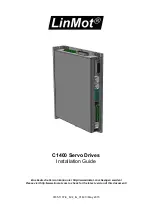
5
Electrical installation
Notes on the supply
Operating Instructions – CMP ELVCD
26
5.4.3
Switching example with enable input and ready signal
The following figure shows a switching example with input DI09 for enabling the
ELVCD drive and the output for the "Ready" signal:
[1]
[2]
[3]
ELVCD
MOVI-PLC
®
C
AN
DHP11B
X3
0
2
2
2
2
0
1
2
18087117451
[1]
Supply of ELVCD electronics
[2]
Enable/switch on output stage, set to 24 V (fixed),
jumpered in plug connector or switchable
[3]
"Ready" signal lamp
5.5
Notes on the supply
5.5.1
Dimensioning the DC 24 V supply
The required power of the DC 24 V supply depends on the number and the current
consumption of the connected ELVCD drives.
The current demand of an ELVCD drive is a combination of the basic current con-
sumption of the electronics and the current consumption of the used options (e.g.
brake).
5.5.2
Dimensioning the DC 48 V supply
The DC 48 V supply must provide the power that is required at the output shaft of the
ELVCD drive. Determine the maximum power demand observing the efficiency.
A power supply with a nominal output of 500 W makes operation below the S1 charac-
teristic curve possible (40 °C, see chapter Thermal characteristic curves). With dy-
namic capacity utilization, the power demand can be up to 1200 W.
For further information, refer to chapter "Technical data" (→
94).
5.5.3
Regenerative operation
In regenerative operation (braking operation) of the ELVCD drive, energy is fed into
the DC 48 V supply circuit. This results in a rise of the supply voltage at the ELVCD in-
verter and at the 48 V power supply unit output. The inverter does not limit the voltage
increase until the supply voltage exceeds the switch-on threshold of the brake chop-
per.
Switched-mode power supplies are equipped with output voltage monitoring. If the
output voltage that is present at the power supply unit exceeds the value of the
device-dependent switching threshold, this can lead to the voltage supply being
switched off. The ELVCD drive is no longer supplied with 48 V and signals a failure.
Further operation is only possible after a reset.
22759468/EN – 11/2017
















































